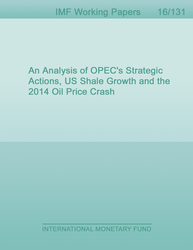
An Analysis of OPEC’s Strategic Actions, US Shale Growth and the 2014 Oil Price Crash
In November 2014, OPEC announced a new strategy geared towards improving its market
share. Oil-market analysts interpreted this as an attempt to squeeze higher-cost producers
including US shale oil out of the market. Over the next year, crude oil prices crashed, with
large repercussions for the global economy. We present a simple equilibrium model that
explains the fundamental market factors that can rationalize such a "regime switch" by
OPEC. These include: (i) the growth of US shale oil production; (ii) the slowdown of global
oil demand; (iii) reduced cohesiveness of the OPEC cartel; (iv) production ramp-ups in other
non-OPEC countries. We show that these qualitative predictions are broadly consistent with
oil market developments during 2014-15. The model is calibrated to oil market data; it
predicts accommodation up to 2014 and a market-share strategy thereafter, and explains large
oil-price swings as well as realistically high levels of OPEC output.
Publication date: July 2016
ISBN: 9781498351638
$18.00
Add to Cart by clicking price of the language and format you'd like to purchase
Available Languages and Formats
| English |
Prices in red indicate formats that are not yet available but are forthcoming.
Topics covered in this book
This title contains information about the following subjects.
Click on a subject if you would like to see other titles with the same subjects.
Economics- Macroeconomics , Economics- Macroeconomics , Economics / General , Economics / General , International - Economics , International - Economics , Crude oil , OPEC , price crash , shale oil , market share , limit pricing
Summary
Copyright © 2010 - 2024
Powered by:
AIDC



